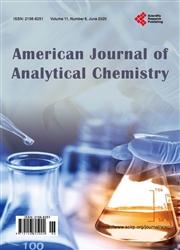Quality Control of Tramadol in Kisangani: Development, Validation, and Application of a UV-Vis Spectroscopic Method
引用次数: 3
Abstract
Context: Substandard and falsified medicines are circulating in low-income countries mostly without any control. We availed a simple and not expensive UV-Vis spectroscopic method to evaluate the quality of tramadol in Kisangani before and during the Covid-19 period. Methods: For the analytical quantitative method, an experimental design was applied to set up the optimal levels of the selected factors, namely, pH of dissolution medium, type of cuvette, and wavelength. Taking into account the capsule pharmaceutical formulation within 80 - 120 μg·mL-1 concentration range, we analyzed 89 tramadol samples from pharmacies and hospitals of the six Kisangani municipalities. Results: pH showed a significant effect on absorbance, whereas quartz cuvette and wavelength did not. A typical 100 μg·mL-1 tramadol solution gave an absorbance of 0.64 at 272 nm. Validation highlighted a matrix effect observed with a 6% bias. A correction factor of 0.9372 allowed to improve the accuracy profile, which were then totally included within the 10% acceptance limits. Quality control revealed that 25 samples out of 89 were not compliant in terms of manufacturing license, registration status in DRC and content as well. Conclusion: This study showed that the strengthening of analytical strategy in Kisangani is a need.基桑加尼曲马多的质量控制:紫外-可见光谱法的开发、验证和应用
背景:不合格和假药在低收入国家流通,大多没有任何控制。我们利用一种简单而不昂贵的UV-Vis光谱方法来评估新冠肺炎期间和之前基桑加尼曲马多的质量。方法:对于分析定量方法,采用实验设计来确定所选因素的最佳水平,即溶解介质的pH、比色杯的类型和波长。考虑到80-120μg和middotmL-1浓度范围内的胶囊药物制剂,我们分析了基桑加尼六个市的药店和医院的89份曲马多样品。结果:pH对吸光度有显著影响,石英比色杯和波长对吸光度无显著影响。典型的100μg和middotmL-1曲马多溶液在272 nm处的吸光度为0.64。验证强调了在6%偏差下观察到的矩阵效应。0.9372的校正系数可以改善精度分布,然后将其完全包括在10%的可接受范围内。质量控制显示,89个样品中有25个在生产许可证、刚果民主共和国注册状态和含量方面不合格。结论:本研究表明,有必要加强基桑加尼的分析战略。
本文章由计算机程序翻译,如有差异,请以英文原文为准。
求助全文
约1分钟内获得全文
求助全文

 求助内容:
求助内容: 应助结果提醒方式:
应助结果提醒方式:


